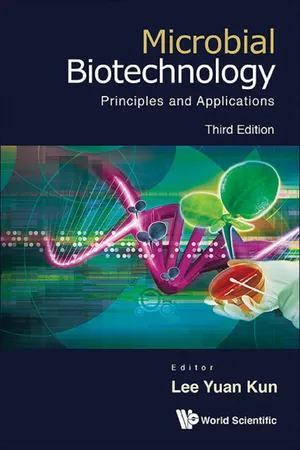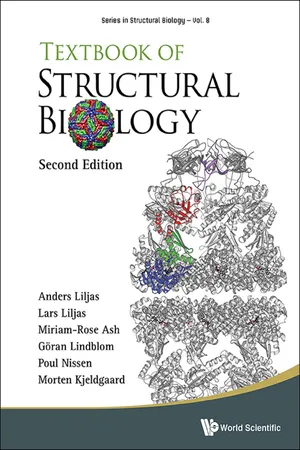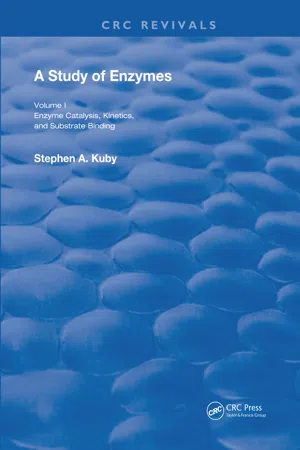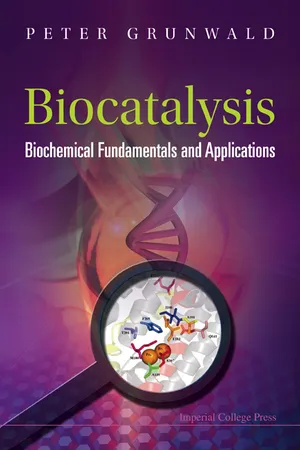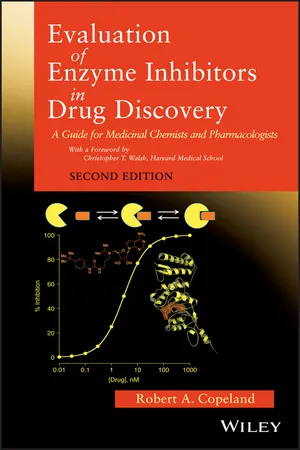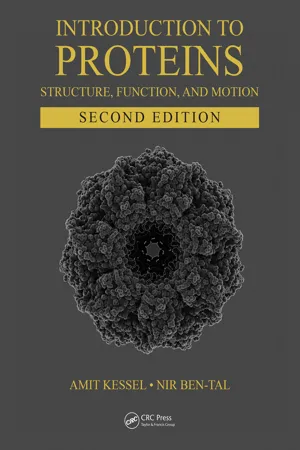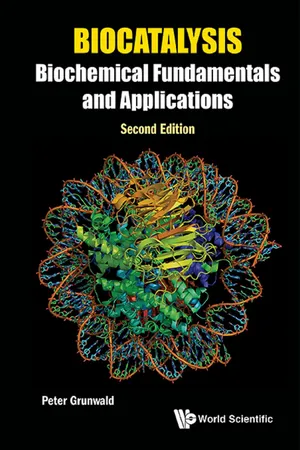Chemistry
Induced fit model
The induced fit model describes the dynamic interaction between an enzyme and its substrate. It proposes that the enzyme undergoes a conformational change upon binding to the substrate, resulting in a better fit between the two molecules. This model emphasizes the flexibility of both the enzyme and the substrate, allowing for optimal binding and catalysis.
Written by Perlego with AI-assistance
Related key terms
Related key terms
1 of 4
Related key terms
1 of 3
8 Key excerpts on "Induced fit model"
- eBook - ePub
Microbial Biotechnology
Principles and Applications
- Yuan Kun Lee(Author)
- 2013(Publication Date)
- WSPC(Publisher)
Fig. 4.2 ). This model presents the active site as a rigid unchanging structure. In the Induced fit model, the enzyme is not presented as a rigid molecule. Rather, the enzyme undergoes conformational change as theFig. 4.2. Lock and key model for enzyme-substrate interaction. The enzyme is analogous to a lock while the substrate is viewed as the key that fits specifically into the lock.Fig. 4.3. Induced fit model of enzyme-substrate interaction. Substrate binding will alter the conformation of the active site such that the enzyme and substrate fit each other more precisely.substrate binds and as the reaction proceeds (Fig. 4.3 ). Such conformational changes have indeed been proven to occur by X-ray crystallographic studies, as in the case of the yeast hexokinase enzyme (Steitz et al., 1981).4.2. Nomenclature
Before the Enzyme Commission (EC) recommended the present system of nomenclature, enzymes were given trivial names. The trivial names consisted of the suffix -ase added to the substrate of the enzyme (e.g. urease), or implied something about the nature of the reaction (e.g. alcohol dehydrogenase), or simply did not give any clue to what the enzyme does (e.g. trypsin).The EC was set up by the International Union of Biochemistry and Molecular Biology (IUBMB). Based on the EC recommendation, enzymes are classified and named according to the nature of the chemical reactions they catalyzed (Enzyme Nomenclature, 1992). There are six major classes of enzyme reactions (Table 4.1). The major classes are further subdividedTable 4.1. Classification of enzyme reactions.ClassificationType of reaction Class of enzymeinto subclasses and sub-subclasses. Each enzyme has a unique EC numberand a systematic name with the suffix -ase. The systematic name of anenzyme consists of the name of its substrate(s) followed by a word endingwith “ase” specifying the type of reaction the enzyme catalyzes. The enzyme, glucokinase, catalyzes the transfer of a phosphate from ATP to{§} - eBook - ePub
- Anders Liljas, Lars Liljas;Miriam-Rose Ash;G?ran Lindblom;Poul Nissen;Morten Kjeldgaard(Authors)
- 2016(Publication Date)
- WSPC(Publisher)
This dynamic character is essential for enzyme activity. During binding and catalysis residues of the active site or large parts of the enzymes can undergo conformational changes just like the substrate going through chemical changes. One model that emphasizes the conformational changes of enzyme as well as substrate is called “induced fit” (Figure 8.1). With a conformational change, the groups participating in catalysis get close to each other. A general role of an enzyme is to lower the activation energy of the chemical reaction (Figure 8.2). This can simply be done if the enzyme binds the substrates with optimal proximity and orientation for the reaction to occur. This is analogous to an increase in concentration of the substrates or product. Fig. 8.1 ▪ (a) Simplified enzyme mechanisms. (b) The substrate is forced to bind to the enzyme in a strained conformation, which leads to the degradation of the substrate. The enzyme undergoes a conformational change to bind the substrate and catalyze the reaction. In (a) and (b), the substrate or the enzyme, respectively undergoes an induced fit. The enzyme in the red state stabilizes the transition state. Fig. 8.2 ▪ Chemical reactions have an activation energy. The uncatalyzed reaction is shown with the blue curve. Enzymes catalyze the reaction (red curve) by lowering the activation energy. E means enzyme, S — substrate and P — product. ES* indicates the activated enzyme substrate complex at the transition state. The affinity of an enzyme for the transition state may be greater than for the substrate or the product (“transition state stabilization”). This causes a strain in the substrate. In enzymes that catalyze reactions where covalent bonds are formed or broken, the enzyme may make the substrates bind closer than van der Waals’ distances to assist in the formation of the bond that should be formed. In the opposite direction, the enzyme could strain or pull a covalent bond that should be broken - eBook - ePub
Enzymes
A Practical Introduction to Structure, Mechanism, and Data Analysis
- Robert A. Copeland(Author)
- 2023(Publication Date)
- Wiley(Publisher)
1969 ) has argued that for reversible enzymatic reactions, distortion of the ES complex is a necessary component of catalysis. Consider a reversible enzymatic reaction that proceeds through a nucleophilic attack of a group on the substrate molecule. We could imagine that the enzyme active site and the substrate ground state are both conformationally rigid. The substrate binds to the active site because its ground state configuration fits perfectly into this pocket. In this case, the interatomic distance between the enzymatic nucleophile and the substrate carbon atom that is attacked would be determined by the van der Waals radii of the interacting atoms. If this were so, the rigid product molecule could not have a perfect fit to the same rigid active site structure. Thus, the enzyme–product complex would be destabilized relative to the enzyme–substrate complex as a result of a steric hindrance (hence loss of binding energy). The enzyme could overcome this by distorting the bound product in such a way as to resemble the substrate molecule more closely. This would facilitate reaction in the reverse direction. Likewise, if the active site were rigid and fit the product molecule perfectly, the imperfect fit of the substrate molecule would now impede reaction in the forward direction. The need for enzymatic rate acceleration in both the forward and reverse reactions is most effectively accomplished by having the active site structure best matched to a structure intermediate between the substrate and product states—that is, by having the active site designed to best match the transition state structure.However, the foregoing arguments and experimental data are not adequately accounted for by models in which the ground state substrate and the enzyme active site are conformationally rigid, as in the original lock and key model of Fischer. Hence, models are needed that consider the need for conformational flexibility and optimization of the active site‐transition state complementarity. Three major models have been put forth to fill these needs: (1) the induced‐fit model, (2) the nonproductive binding model, and (3) the induced‐strain model.The induced‐fit model, first proposed by Koshland (1958 ), suggests that the enzyme active site is conformationally fluid. In the absence of substrate, the active site is in a conformation that does not support catalysis. When a “good” substrate binds to the active site, the binding forces between the enzyme and the substrate are used to drive the enzyme into an energetically less favorable, but catalytically active conformation (the rack model illustrated in Figure 6.11 is one interpretation of this induced‐fit model). In this model, a “poor” substrate lacks the necessary structural features to induce the conformational change required for catalytic activity and thus, does not undergo reaction. The expected results from the induced‐fit model are that Vmax - eBook - ePub
A Study of Enzymes
Enzyme Catalysts, Kinetics, and Substrate Binding
- Stephen A. Kuby(Author)
- 2019(Publication Date)
- CRC Press(Publisher)
The theory presupposes that the catalytic groups at the active site of the “free enzyme” molecule are not precisely in the correct positions to exert their effective catalytic function. Following the binding of the substrate, however, the binding forces between the enzyme and the substrate force the enzyme into a conformation which is more active catalytically. In the case of a relatively poor substrate or an inhibitor (e.g., a substrate analogue) which may also bind to the active site, these compounds will not possess the necessary structural features to induce the appropriate conformational changes. Bender et al. 552 have noted that the induced-fit theory can account for those cases with relatively large positive and negative entropies of activation which are not readily interpreted otherwise. The theory also can account for the observation that substrate specificity is often found to be more important at high rather than low substrate concentrations. Hexokinase is an enzyme to which the induced-fit hypothesis had been applied. As first noted by Colowick, 553 hexokinase not only catalyzes the phosphoryl group transfer from ATP to the 6-hydroxyl group of glucose, but also to water, i.e., the enzyme also possesses ATP-ase activity. However, the rate of reaction with water is only 5 × 10 −6 that with glucose as the phosphoryl group acceptor; the difference in rate calculates to be equivalent to approximately 7 kcal of ΔG ‡. Thus, the suggestion has been made that a water molecule lacks those chemical side groups necessary to induce a distortion of the enzyme, which glucose possesses, and which will form a more reactive complex with the enzyme. It is of interest that J. B. S. Haldane 554 put forth an alternative theory which was later developed by Jencks. 555 The theory postulates that the binding forces between the substrate and the enzyme are directly utilized to bring about the strain or distortion in the substrate molecule - eBook - ePub
Biocatalysis
Biochemical Fundamentals and Applications
- Peter Grunwald(Author)
- 2009(Publication Date)
- ICP(Publisher)
According to Fischer's theory one might argue that the substrate molecules are too large to form an enzyme substrate complex but it was found that they bind strongly to the enzyme and act as competitive inhibitors. (Thoma et al, 1960). Non-competitive inhibition (chapter 6.1.4.1) is another example. How can such an inhibitor be bound to the enzyme in a certain distance from the active site and diminish its catalytic activity other than by inducing structural changes? These and other inconsistencies lead to the formulation of the induced fit theory based on three essentials that are cited here from the original publication: “a) a precise orientation of catalytic groups is required for enzyme action; b) the substrate may cause an appreciable change in the three-dimensional relationship of the amino acids at the active site; and c) the changes in protein structure caused by a substrate will bring the catalytic groups into the proper orientation for reaction, whereas a non-substrate will not” (Koshland, 1958). Related to the interaction of cycloamyloses with β-amylase this means, that the sugar molecule though bound to the enzyme does not induce structural changes in the protein, and hence is a non-substrate. As the main difference between starch and cycloamyloses is that the latter are missing a free OH-group at the C4-position of the terminal unit, it must be this functional group that induces the structural changes indispensable for the catalytic activity. Another interesting result obtained by investigations into the kinetics of β-amylase was that the internal units of the sugar polymer act as competitive inhibitors (chapter 6.1.4.2). Confirmation for the induced fit theory mainly came from progress in X-ray crystal structure analysis and today it is assumed that in most cases substrate binding is accompanied by an induced fit. This theory further gives explanations for other phenomena that characterize the properties of enzymes - eBook - ePub
Evaluation of Enzyme Inhibitors in Drug Discovery
A Guide for Medicinal Chemists and Pharmacologists
- Robert A. Copeland(Author)
- 2013(Publication Date)
- Wiley-Interscience(Publisher)
CHAPTER 2 Enzyme Reaction MechanismsKey Learning Points
- Enzymes catalyze biochemical reactions by first binding substrate molecules and then chemically transforming them into various intermediate states on the way to the final product state.
- Each intermediate form of the substrate along the reaction pathway is accompanied by a unique conformational state of the enzyme.
- Each of these individual conformational states represents a unique opportunity for high-affinity interactions with drug molecules.
The function of enzymes is to accelerate the rates of reaction for specific chemical species. Enzyme catalysis can be understood by viewing the reaction pathway, or catalytic cycle, in terms of a sequential series of specific enzyme–ligand complexes (as illustrated in Figure 1.6), with formation of the enzyme–substrate transition state complex being of paramount importance for both the speed and reactant fidelity that typifies enzyme catalysis.2.1 Initial Binding of Substrate
All enzymatic reactions are initiated by formation of a binary encounter complex between the enzyme and its substrate molecule (or one of its substrate molecules in the case of multiple substrate reactions; see Section 2.6 below). Formation of this encounter complex is almost always driven by noncovalent interactions between the enzyme active site and the substrate. Hence the reaction represents a reversible equilibrium that can be described by a pseudo–first-order association rate constant (kon ) and a first-order dissociation rate constant (koff ) (see Appendix 1 for a refresher on biochemical reaction kinetics):The binary complex ES is commonly referred to as the ES complex, the initial encounter complex, or the Michaelis complex. As described above, formation of the ES complex represents a thermodynamic equilibrium, and is hence quantifiable in terms of an equilibrium dissociation constant, Kd , or in the specific case of an enzyme–substrate complex, KS , which is defined as the ratio of reactant and product concentrations, and also by the ratio of the rate constants koff and kon - eBook - ePub
Introduction to Proteins
Structure, Function, and Motion, Second Edition
- Amit Kessel, Nir Ben-Tal(Authors)
- 2018(Publication Date)
- Chapman and Hall/CRC(Publisher)
catalysis ). As we will see below, they do so by promoting the conversion of the substrate either into its transition state or into another intermediate downstream of the reaction coordinate. This is done either through chemical reactions between substrate and active site groups (amino acids, cofactors) or via noncovalent stabilization of reaction intermediates by these groups. The latter shows that binding and catalysis are often not mutually exclusive.Substrate binding and catalysis often take place in a single location inside the active site. However, when the substrate is large or has a complex structure, the enzyme may contain multiple binding sites, each binding a different part of the substrate. Still, only one of these sites carries out the catalysis, specifically, the site that binds the labile part of substrate that is supposed to be chemically transformed.As explained above, both substrate binding and catalysis are carried out by chemical groups in the enzyme’s active site, which either react or interact specifically with the substrate. This specificity is created by the shape of the active site and the spatial distribution of its chemical groups. Indeed, enzymatic active sites have been evolutionarily selected to complement their natural substrates[150 ], both geometrically and electrostatically[151 –153 ]*1. This complementarity is responsible for the selectivity of enzymes towards their cognate substrates over other molecules, as well as for their catalytic efficiency and reaction specificity. These key aspects are further discussed in the subsections below.9.3.2 Binding specificity and selectivityEnzymes are known to bind their substrates selectively, i.e., to favor cognate substrates over non-cognate ones. Selectivity exists both in the ground state (which we discuss here) and in the transition state (which we discuss in Subsection 9.3.3.2 below) of the substrate, with selectivity in the transition state being stronger[153 ]. In both cases, the selectivity results from attractive and repulsive*2noncovalent interactions between the active site and substrate, with attractive interactions being stronger with cognate substrates, and repulsive interactions, which have a larger effect, being stronger with non-cognate substrates [153] - eBook - ePub
Biocatalysis
Biochemical Fundamentals and Applications
- Peter Grunwald(Author)
- 2017(Publication Date)
- WSPC (EUROPE)(Publisher)
key and lock in order to enable a chemical effect”. In this analogy the substrate represents the correctly sized key with correctly arranged and sized teeth on it, mimicking the functional groups, and the lock is the enzyme itself containing the active site as the key hole.The key and lock (or template) theory is still valid and of great use. However, not all experimental results that emerged from progress in enzymology could be explained by this rigid model. Protein dynamics as discussed in the previous Chapter provide, e.g., a link between hydrogen tunneling and the catalysis of C–H bond cleavage. Protein motions are also associated with substrate/ligand binding and release. An advancement of Fischer’s ideas is the induced fit theory proposed by Koshland (1958), which is based on the assumption of structural flexibility of the enzyme molecule with the consequence that free enzyme (often named the open form) and enzyme-substrate complex (closed form) are different in their three-dimensional shape. Koshland’s first publication met with some opposition in the scientific community; meanwhile, these ideas are the basis for understanding enzyme catalysis. Koshland (1995) developed his theory by analyzing ‘anomalies’ of enzymatic catalysis that were in contradiction to Fischer’s key and lock model. An important one is that substrate analogs had meanwhile become known which are not converted by the action of the respective enzyme though being bound to it. Good examples are cyclohexa- and cyloheptaamylose that are not cleaved by β-amylase, an enzyme that degrades starch from the reducing end by formation of maltose units. According to Fischer’s theory one might argue that the substrate molecules are too large to form an enzyme/substrate complex but it was found that they bind strongly to the enzyme and act as competitive inhibitors. (Thoma and Koshland, 1960). Non-competitive inhibition (Chapter 6.1.4.1 ) is another example. How can such an inhibitor be bound to the enzyme in a certain distance from the active site and diminish its catalytic activity other than by inducing structural changes? These and other inconsistencies lead to the formulation of the induced fit theory based on three essentials that are cited here from the original publication: “a) a precise orientation of catalytic groups is required for enzyme action; b) the substrate may cause an appreciable change in the three-dimensional relationship of the amino acids at the active site; and c) the changes in protein structure caused by a substrate will bring the catalytic groups into the proper orientation for reaction, whereas a nonsubstrate will not”
Index pages curate the most relevant extracts from our library of academic textbooks. They’ve been created using an in-house natural language model (NLM), each adding context and meaning to key research topics.
Explore more topic indexes
Explore more topic indexes
1 of 6
Explore more topic indexes
1 of 4
